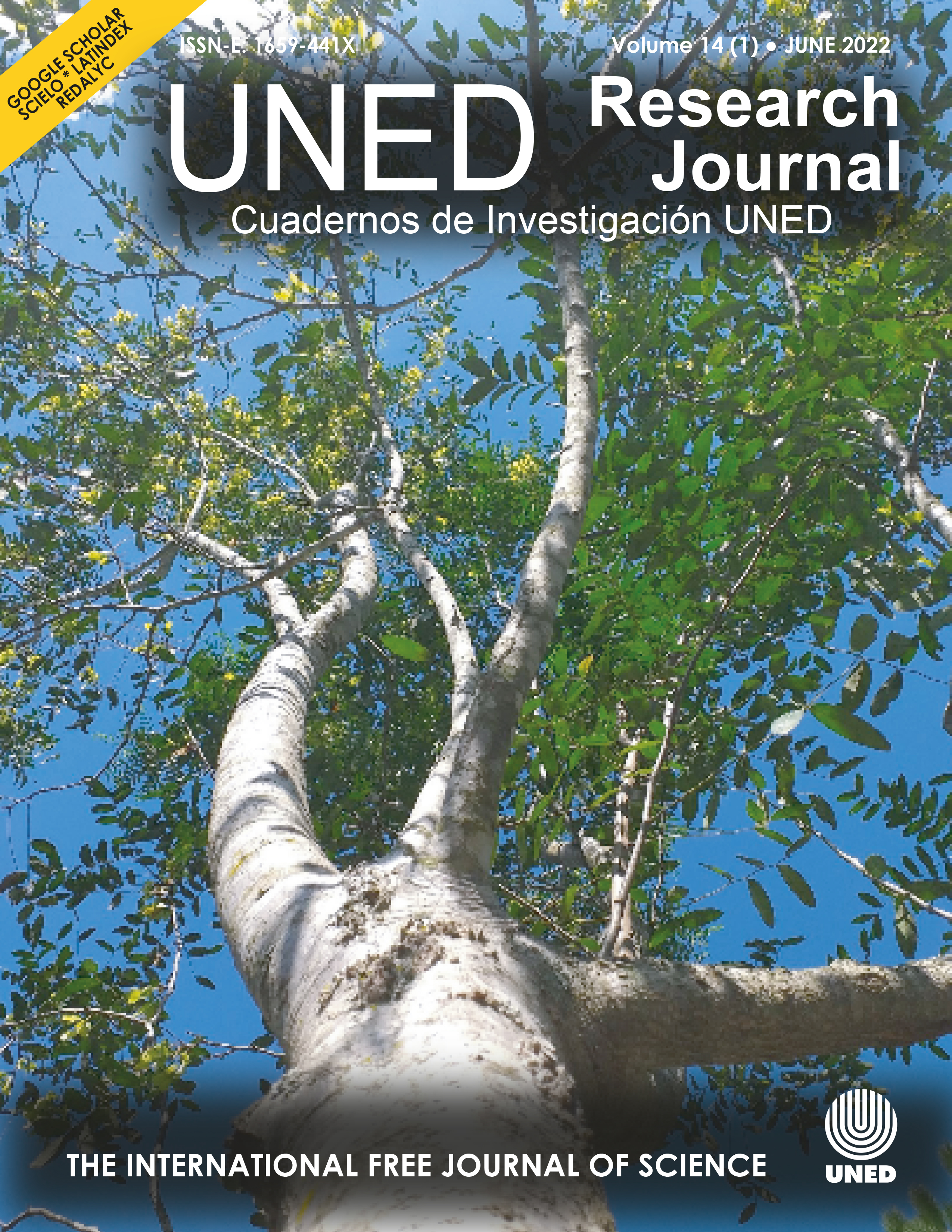Effect of birds and temperature on the germination and viability of Rubus ulmifolius (Rosaceae) seeds
DOI:
https://doi.org/10.22458/urj.v14i1.3786Keywords:
Keywords: Germination power, fires, frosts, dispersal, blackberryAbstract
Introduction: Invasive species is causing great modifications worldwide, affecting both deserts and tropical forests. In the province of Córdoba, Argentina, the distribution and abundance of blackberry (Rubus ulmifolius) has been seriously increased in recent times both in natural and rural environments. The appearance of these plants in isolated areas has been attributed to birds, which have been mentioned as one of the main responsible for their dispersal; however, there are no studies referring to the consumption of blackberry by them. On the other hand, forest fires and the proliferation of invasive alien species can positively interact with each other, increasing the impact of these species on invaded ecosystems. Objectives: a) to know if the birds disperse the blackberry seeds, b) to know if the birds affect the germination of said seeds and c) to know the effect of high and low temperatures on their germination and viability. Results: 80 blackberry seeds were extracted from the feces of the birds, which did not present any type of physical damage. These seeds did not germinate after 20 months, but they remained viable. Significant differences were observed in the viability of the fruit seeds and those subjected to high and low temperature treatments (H: 21.50, p = 0.0054). The greatest effects were observed for extreme temperatures, both hot and cold. Conclusion: blackberry seeds have low germination power since they did not germinate under any treatment after 20 months in favorable conditions of light, temperature and humidity. Birds make a “legitimate” dispersal of blackberry seeds, which are also highly resistant to high and low temperatures, although surface fires could destroy these seeds
References
Alba-Lynn C., & Hen, S. (2010). Potential for ants and vertebrate predators to shape seed-dispersal dynamics of the invasive thistles Cirsium arvense and Carduus nutans in their introduced range (North America). Plant Ecology, 210, 291-301. https://doi.org/10.1007/s11258-010-9757-2
Alexander J.M., & D’Antonio, C. (2003). Seed bank Dynamics of French Broom. In Coastal California grasslands: effects Of Stand Age and prescribed burning on control and Restoration. Restoration Ecology, 11(2), 185-197. https://doi.org/10.1046/j.1526-100X.2003.00169.x
Cabrera, A. L. (1976). Enciclopedia Argentina de agricultura y jardinería: Regiones fitogeográficas Argentinas. Editorial Acme.
Carballas-Fernández, T. (2003). Los incendios forestales. En J. J. Casares (Ed.), Reflexiones sobre el medio ambiente en Galicia (pp. 363-415). Consellería de Medio Ambiente Centro de Desenvolvemento Sostible.
Cottrell, H. J. (1947). Tetrazolium salt as a seed germination indicator. Nature, 159, 748. https://doi.org/10.1038/159748a0
D’Antonio, C.M., & Vitousek, P.M. (1992). Biological Invasions B Exotic Grasses, The Grass/Fire Cycle, And Global Change. Annual Review of Ecology and Systematics, 23, 63-87.
D’Antonio, C.M. (2000). Fire, plant Invasions, And Global Changes. In H. A. Mooney & R.J. Hobbs (Eds.), Invasive Species in a Changing World (65-95). Island Press.
Giorgis, M. A., Tecco, P. A., Marcora, P., Cingolani, M., Paiaro, V., & Renison, D. (2006). Las invasiones biológicas y su problemática ambiental – Manual para docentes. CONICET.
Jordano. P. (1984). Seed weight variation and differential avian dispersal in blackberries. Oikos, 43(2), 149-153. https://doi.org/10.2307/3544762
Lodge, D.M., & Sgrader-Frechette, K. (2002). Nonindigenous Species: Ecological Explanation, Environmental Ethics & Public Policy. Conservation Biology, 17(1), 31-37. https://doi.org/10.1046/j.1523-1739.2003.02366.x
Mackay, D. B. (1972). The measurement of viability. In E. H. Roberts (Ed.) Viability of seeds (pp. 172-208). Chapman and Hall.
Mack, M.C., & D’Antonio, C.M. (1998). Impacts of Biological Invasions on Disturbance Regimes. Trends in Ecology and Evolution, 13(5), 195-198. https://doi.org/10.1016/S0169-5347(97)01286-X
Mack, R.N., Simberloff, D., Lonsdale, W.M., Evans, H., Clout, M., & Bazzaz, F.A. (2000). Biotic Invasions: Causes, Epidemiology, Global Consequences and Control. Ecological Applications, 10(3), 689-710. https://doi.org/10.1890/1051-0761(2000)010[0689:BICEGC]2.0.CO;2
Traveset, A., Riera, N., & Mas R.E. (2001). Passage through bird guts causes interspecific differences in seed germination characteristics. Functional ecology, 15(5), 669-675. https://doi.org/10.1046/j.0269-8463.2001.00561.x
Traveset, A., & Richardson, D.M. (2006). Biological Invasions as disruptors of Plant-Animal Reproductive Mutualisms. Trends in Ecology and Evolution, 21(4), 208-216. https://doi.org/10.1016/j.tree.2006.01.006
Wada S., & Reed B.M. (2011). Optimized scarification protocols improve germination of diverse Rubus germplasm. Scientia Horticulturae, 130(3), 660-664.
Walker, B., & Steffen, W. (1997). An overview of the implications of global change for natural and managed terrestrial ecosystems. Conservation Ecology, 1(2), 1-18. http://www.jstor.org/stable/26271662
Williamson, M. (1999). Invasions. Ecography, 22(1), 5-12. https://doi.org/10.1111/j.1600-0587.1999.tb00449.x
Zasada, J.C., & Tappeiner, J.C. (2003). Rubus L. The Woody Plant Seed Manual U.S.D.A. Forest Service, 162, 9-1638.
Published
How to Cite
Issue
Section
License
Copyright (c) 2022 UNED Research Journal

This work is licensed under a Creative Commons Attribution 4.0 International License.
Note: This abstract contains an incorrect copyright due to technical issues. Authors who publish with this journal agree to the following terms: Authors retain copyright and grant the journal right of first publication with the work simultaneously licensed under a Creative Commons Attribution License that allows others to share the work with an acknowledgement of the work's authorship and initial publication in this journal
All journal contents are freely available through a CC BY 4.0 license.
CC BY 4.0 is a Creative Commons: you can copy, modify, distribute, and perform, even for commercial reasons, without asking permission, if you give appropriate credit.
Contents can be reproduced if the source and copyright are acknowledged according to the Open Access license CC BY 4.0. Self-storage in preprint servers and repositories is allowed for all versions. We encourage authors to publish raw data and data logs in public repositories and to include the links with all drafts so that reviewers and readers can consult them at any time.
The journal is financed by public funds via Universidad Estatal a Distancia and editorial independence and ethical compliance are guaranteed by the Board of Editors, UNED. We do not publish paid ads or receive funds from companies.
